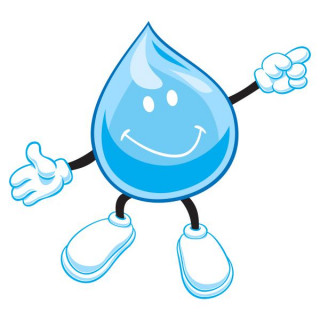Kalamazoo, Michigan gets 36 inches of rain, on average, per year. The US average is 38 inches of rain per year. Kalamazoo averages 60 inches of snow per year. The US average is 28 inches of snow per year.
-Henry the Water Drop

Henry Says
Stormwater
What gets to the street, gets to the Creek!
To understand the importance of stormwater in our community, let's start with the basics. This photo shows two important concepts: precipitation (snow/rain) and surface water (stream).

PRECIPITATION is rain, snow, sleet, or hail that falls to the ground as a part of the water cycle.
SURFACE WATER is water that collects on the ground surface from precipitation (oceans, streams, lakes, ponds, and other bodies of water found on the Earth's surface).
This photo exemplifies two more important concepts: Stormwater (rain) and Stormwater Runoff (puddles).

STORMWATER originates from precipitation and is a type of surface water created during abnormally large rain or snow falls.
STORMWATER RUNOFF is stormwater running off, draining away and flowing over ground surfaces. It is created when rainfalls or snowmelts runoff roads, driveways, parking lots, rooftops and other paved or impervious surfaces that do not allow water to soak into the ground.
After the rain, where does stormwater runoff go?
a) It seeps by infiltration into the ground through pores in the soils and downward into and through the ground (contributing to groundwater).
b) Some of it evaporates into the air and returns to the water cycle. z
c) Stormwater may also drain directly into natural surface water features including our lakes, streams, wetlands and marshes.
d) It becomes runoff in urban areas flows into catch basins that carry the water through the storm sewer pipes of Kalamazoo's MUNICIPAL STORMWATER SEWER SYSTEM. Catch basins are the drains you see at street corners or at low points on the sides of your streets and parking lots.
e) The municipal stormwater sewer system releases captured stormwater into streams, rivers, lakes and wetland areas. Sometimes the stormwater may travel for miles in the stormwater sewer system before being released.
WATERSHED, an area of land that drains to a single surface water outlet and is separated from other watersheds by a divide.
The surface water bodies in and around Kalamazoo release stormwater primarily to the Portage Creek/Arcadia Creek watershed. This is the primary watershed covering the NPDES Permit for the City of Kalamazoo. It includes Portage Creek the West Fork of Portage Creek, Arcadia Creek and Axtell Creek. The Kalamazoo River Main Stem Corridor 3 is the secondary watershed, including Davis Creak (Davis-Olmstead Drain).
The draining water, stormwater runoff, is a concern to us since it can mix with chemicals spilled on surfaces like oil, grease, toxics, pathogens, sediment and other pollutants. This is how pollutants get to our groundwater, stormwater sewers, streams, lakes and wetlands potentially causing health related issues. According to EPA, 70% of pollutants are from stormwater runoff. That is why stormwater is important to our community!
 After The Storm....a citizens guide to understanding stormwater
After The Storm....a citizens guide to understanding stormwater
USE OF NATIVE VEGETATION
Low Impact Development Manual
BENEFITS AND MANAGEMENT OF RIPARIAN ZONES
• What is a Riparian Zone?
• Benefits of Riparian Zones
Kalamazoo Stormwater Sewer facts:
- 11,564 catch basins and inlets
- 4,914manholes
- 256 leaching basins
- 119 culverts
- 443 outfalls (water & ground)
- 192 miles of storm main + 50 miles of connection pipe
- 11 City-Owned Pre-Treatment Sites
- 164 Private Pre-Treatment Sites
Get Involved!
You can help keep Kalamazoo's water clean! Some tactics include using your property wisely, disposing of hazardous products properly, conserving water, and more. Learn about proper disposal and ways to conserve water.
